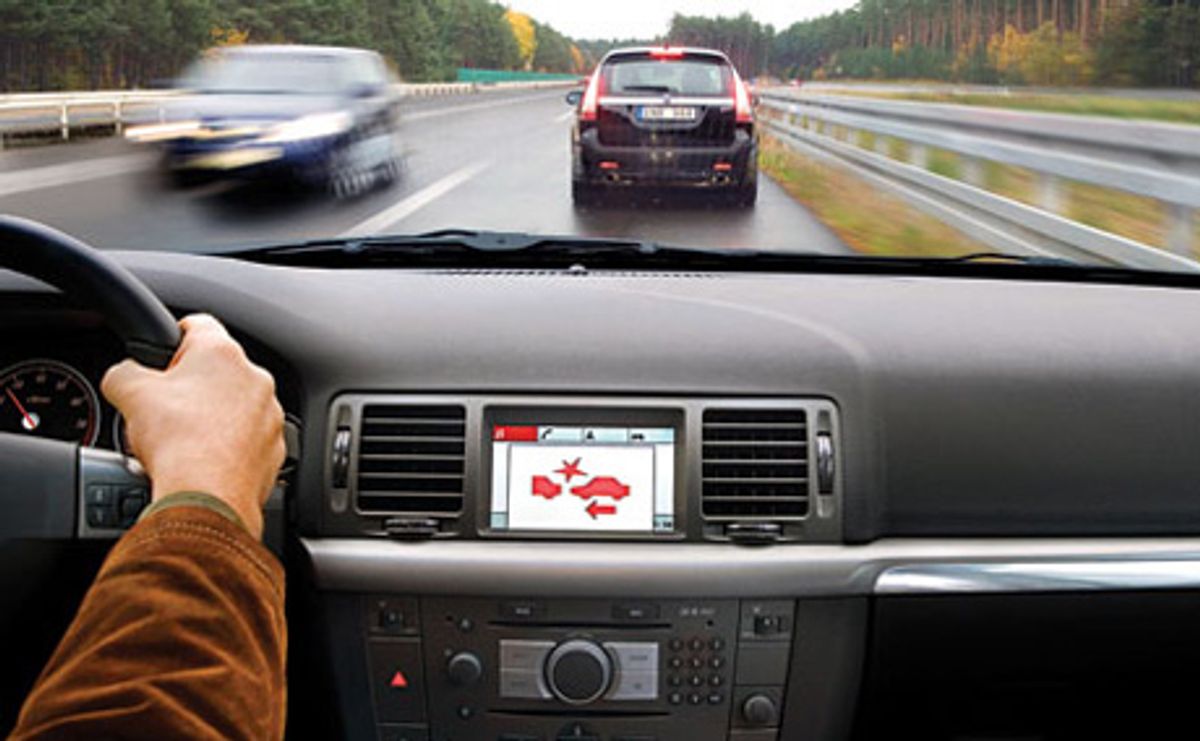Under pressure to improve safety and reduce traffic congestion, fuel consumption, and carbon dioxide emissions, the European Union has spawned a batch of projects to give cars the ability to communicate wirelessly with the road and among themselves. The effort, similar to some in Japan and the United States, has reached a major milestone following a June EU ruling that set aside RF spectrum for vehicle-to-vehicle communication. Those developing car- and road-communications systems will begin testing their wares this fall ahead of large-scale road trials at six sites in Europe, which will begin in early 2009. Experts expect the technologies to begin commercial deployment as soon as 2011.
There's been no shortage of ideas. A car might share data with other vehicles over a distance of 20 to 200 meters, giving the driver enough time to intervene and avoid a crash or, if a crash is inevitable, to provide data that optimizes usage of air bags, motorized seat-belt pretensioners, and extendable bumpers. Or a vehicle could communicate directly with others and with roadside infrastructure, using a dynamic local map to help the driver quickly respond to warnings of congestion and make better decisions about his or her route. Now these and other concepts are being tested at the Lindholmen Science Park, in Göteborg, Sweden.
”In some respects, we're guessing what early winner applications and services could be,” says Paul Kompfner, head of development at ERTICO-ITS Europe, a public-private partnership that includes major carmakers, IT vendors, and telecommunications service providers focused on developing and deploying intelligent transportation systems and services. ”These are intended to be good examples of the spread of systems that could be deployed in the first wave.”
One of them could be the Cooperative Vehicle-Infrastructure Systems (CVIS) project. Led by ERTICO, CVIS has been developing software and hardware for onboard and roadside units for use in 10 different applications, including monitoring speed and hazardous goods.
CVIS collaborates closely with the Safespot Integrated Project, another EU-funded initiative, which is focused largely on preventing accidents through intelligent car and road communications systems. Both projects aim to provide a proof of concept for all their tested systems in 2009.
In an important step toward getting these systems on the road, the European Commission agreed to an EUâ''wide frequency band, 5.9 gigahertz, and allocated 30 megahertz of spectrum for vehicle and roadside infrastructure communications. The frequency is to be used mostly but not exclusively for road safety applications, according to Kompfner.
Both CVIS and Safespot use the 5.9â''GHz frequency and are based on IEEE 802.11p wireless technology, says CVIS project manager Peter Christ. The proposed standard is a flavor of Wi-Fi, specially designed for data exchange among moving vehicles and road infrastructure.
Though they'll use the same band, vehicle-to-vehicle and vehicle-to-infrastructure applications have different needs. ”One of the big differences between the various applications being tested in both groups is Safespot's need for very low latency and short response times” because it must be able to prevent accidents, says Christ. And because for many of its applications CVIS requires more bandwidth than the 30 MHz allotted by the EU, ERTICO is proposing to use the 5.4-GHz band in addition, he says.
Several other research initiatives hope to contribute their work as well. The EU anticipates that by supporting multiple projects and allocating frequency, it will accelerate deployment of an EU-wide system.
About the Author
JOHN BLAU, who lives in Düsseldorf, Germany, has been contributing to IEEE Spectrum for nearly 20 years. Though he’s written for us about such diverse topics as low-power processors, peer-to-peer TV, and robotics, his article, ”Car Talk”, about vehicle-to-vehicle communications schemes, is a natural fit. ”I’m based in a country whose economy is highly dependent on car manufacturing,” he points out.
